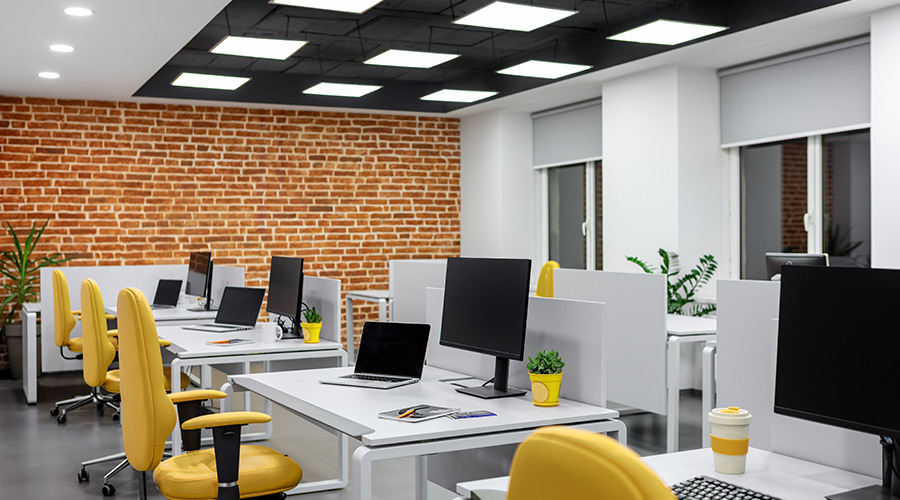Outlook
For yours ears only: acoustics and workplace privacy
Privacy and security are significant issues in facility management, yet facility executives often overlook the importance of acoustics in addressing these concerns. While most privacy concerns stem from worries that conversations could be overheard, security issues focus on thwarting eavesdropping.
Corporate espionage is a significant concern when a competitive advantage or building safety is at stake, says Fred Folsom, executive vice president of Dynasound Inc.
Specialized sound-masking systems can provide some protection from electronic eavesdropping tools, such as parabolic microphones, Folsom says. For example, sound-masking devices with transducers mounted on doors and windows vibrate the structure’s surface. The vibration masks sound and prevents listening equipment from registering conversations through windows and doors.
More common security threats and privacy invasions are likely to be internal. Human resource matters often involve confidential information. Meetings with clients can raise privacy issues. Doctor-patient discussions are one more example of the importance of confidentiality.
“For eavesdropping on normal speech, you would approach it a little differently,” says Rik Master, manager of architecture and construction systems, USG. “You would want to kill the sound or mask it as soon as you can.”
Privacy laws
The Health Insurance Portability and Accountability Act of 1996 (HIPAA) has medical facility executives scratching their heads over what “private” means. According to the U.S. Department of Health and Human Services’ Office for Civil Rights, the purpose of HIPAA is to limit the circumstances where an individual’s protected health information can be disclosed. HIPAA considers oral conversations with the patient and among staff members as protected information.
“This law touches on speech privacy,” says Niklas Moeller, vice president of K.R. Moeller Associates Ltd. “There is a need for better sound consideration to prevent others from overhearing medical information. There is a need for improving speech privacy.”
The law states that “a covered entity must maintain reasonable and appropriate administrative, technical and physical safeguards to prevent intentional or unintentional use or disclosure.” Health care providers are left to “review their own practices and determine what steps are reasonable to safeguard patient information.”
“Proper planning is essential for any company that handles personal, medical and financial information,” says Jonathan Leonard, vice president of Lencore Acoustics Corp. “Federal laws like HIPAA and The Financial Modernization Act will dictate privacy needs for this information.”
The Financial Modernization Act of 1999, also known as the Gramm-Leach-Bliley Act, applies privacy rules similar to HIPAA to financial information obtained by banks, credit reporting agencies and other companies that deal in financial products.
Enforcement actions
In a September 2004 report, the U.S. General Accounting Office reported that more than 5,600 complaints had been filed under this law since April 2003. According to the report, more than half of the complaints were related to “impermissible uses and disclosures,” which included oral disclosure. While most complaints were unfounded, more than 200 were deemed valid and corrections ordered.
“As of yet, the federal government has not enforced the HIPAA legislation to the maximum it should, and many issues are not being addressed, and probably will not be, until more teeth are put in enforcement,” Folsom says. “However, individual hospitals and clinics are addressing poor speech privacy between doctors’ offices because it is a major factor in patient satisfaction.”
Eavesdropping can also be a problem in commercial buildings where financial institutions are housed. Folsom says his company’s research shows that the spaces of most concern are typically board rooms, executive offices, conference areas, and research and development facilities.
Experts agree that stopping sound and ensuring privacy require multiple measures. The two most common structural solutions for speech privacy include upgrading ceilings and wall treatments with higher sound-absorbing materials and installing sound-masking equipment.
The ceiling is a good place to start. “In most architectural spaces, the ceiling is the single largest surface, and it’s the biggest surface you can do something about,” says Ken Roy, an acoustics expert for Armstrong World Industries. “Usually, the ceiling is the easiest and cheapest way to design and apply sound absorptive treatments in a room.”
Sound-masking systems infuse a constant, unobtrusive background noise into a space, making normal speech volume unintelligible beyond 15 or 20 feet, depending on the office layout, Moeller says. Sound masking also can improve productivity by establishing a consistent noise level throughout the work space.
“Acoustics should be evaluated in the project planning stage so problems can be avoided,” Leonard says.
Negative impact
Acoustical performance is often overlooked when productivity is being evaluated. “Noise affects everyone ,” Leonard says. “Poor acoustics has a negative impact on occupants whether they are office workers, school children or visitors to a space.”
Facility executives should become familiar with industry standards issued by organizations such as the American National Standards Institute, the International Standards Organization and the American Society of Testing and Materials, Leonard says. Those standards can help facility executives to shop for ceiling and sound-masking products that meet their needs.
Facility executives should note the material used in an acoustical product, says Kim Graaskamp, director of sales and marketing for Hunter Douglas. “Organic materials that allow mold and mildew to grow may contribute to absenteeism and exacerbate allergies. An inorganic material is not a good host environment for mold and mildew.”
Volatile organic compound (VOC) emissions from acoustical materials could also contribute to indoor air problems, says Master.
Determining which acoustical material and which masking system is best for a given space often requires expert consultation. However, the results can ensure the space meets the needs of occupants.
Lynn Proctor Windle, a contributing editor for Building Operating Management, is a freelance writer who has written extensively about real estate.
Related Topics:











